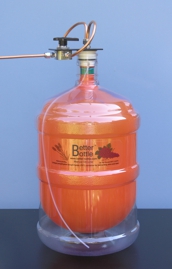|
|||||
|
|
| Introduction | |||
| BetterBottle
PET fermentation carboys were introduced to the home winemaking and
brewing markets in the Spring of 2003, as safe and easily
handled alternatives to glass carboys, and they have been widely
used to ferment and bulk age excellent wines and beers ever since.
They are made of special virgin PET and they are made in a manner
that packs the plastic molecules very tightly and creates a delicate
balance between microcrystaline and amorphous regions.1 The
success of the BetterBottle PET fermentation carboys and
fittings is empirical evidence that they have extremely low
permeability for oxygen; however, it is now possible to make direct
measurements. Breakthrough Technology - Exciting new instrumentation, has made it possible to measure oxygen concentrations as low as 0.001% in closed spaces, quickly and easily. BetterBottle is using this technology to measure the traces of oxygen that permeate through the walls of BetterBottle carboys as well as to determine how much oxygen permeates through or leaks by a wide variety of closures and air locks. Minute traces of oxygen do permeate through the walls of BetterBottle PET carboys; however, the amounts are less than recommended for micro-oxygenation (MOX) and insignificant when compared with the amounts of oxygen diffusing through, or leaking past, many types of carboy caps, stoppers (especially silicone stoppers), and liquid-filled air locks. Moreover, oxygen diffuses into, and reacts with, wine and beer so quickly that removing a closure from a carboy, even briefly, for testing and making adjustments can allow a large amount of oxygen to enter. And racking from one open carboy to another open carboy with a siphon, a more or less standard approach when glass carboys are used, will add an extraordinary amount of oxygen in an uncontrolled manner. The use of ported BetterBottle carboys and BetterBottle fttings drastically reduces, or eliminates, such oxygen contamination.
1 Liu, R Y F. et al. Crystallinity and Oxygen Transport Properties of PET Bottle Walls. J. Applied Polymer Science. 2004 Vol. 94,671-677 (Accessed 01/15/12) 2 Kelly, M. and Wollan, D. Micro-oxygenation of Wine in Barrels. The Australian & New Zealand Grapegrower & Winemaker 2003, Technical Issue 3 Flecknoe-Brownn, A. Oxygen-permeable polyethylene vessels: a new approach to wine maturation. Grapegrower & Winemaker March 2005(Accessed 01/15/12) 4 Davis, K., Science trumps tradition at Napa wine-making facility. Napa Valley Register 10/01/10 (Accessed 01/15/12) | |||




